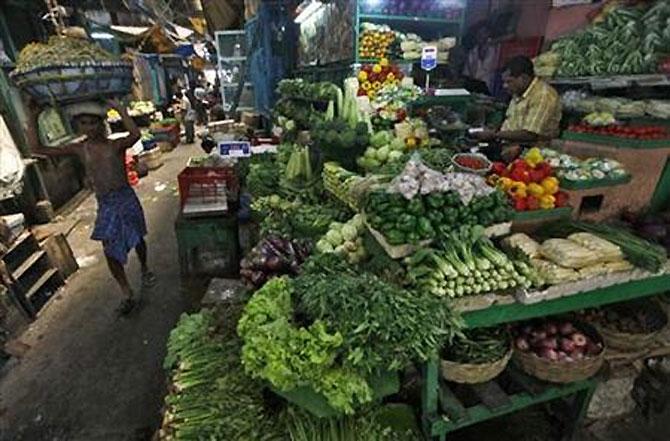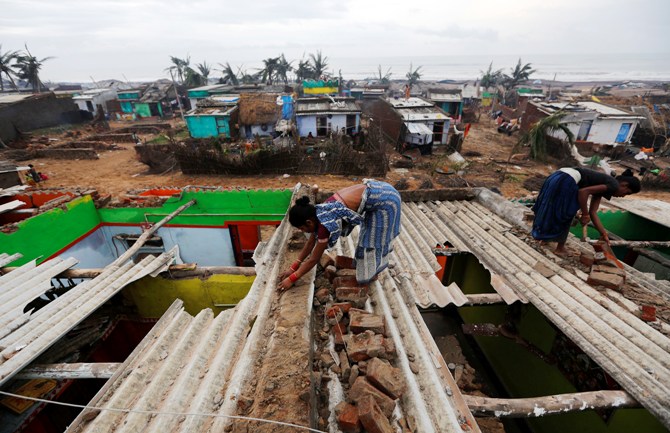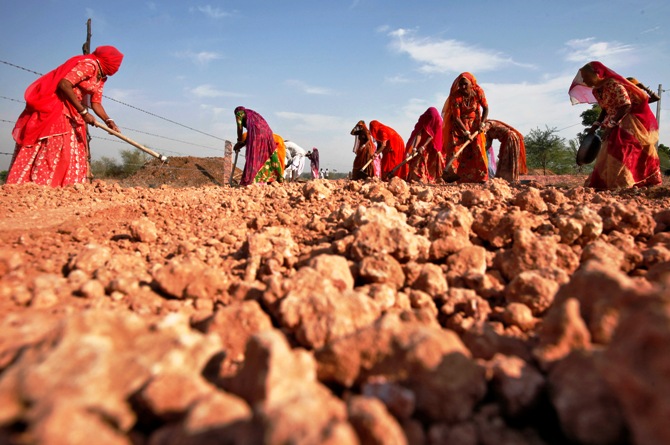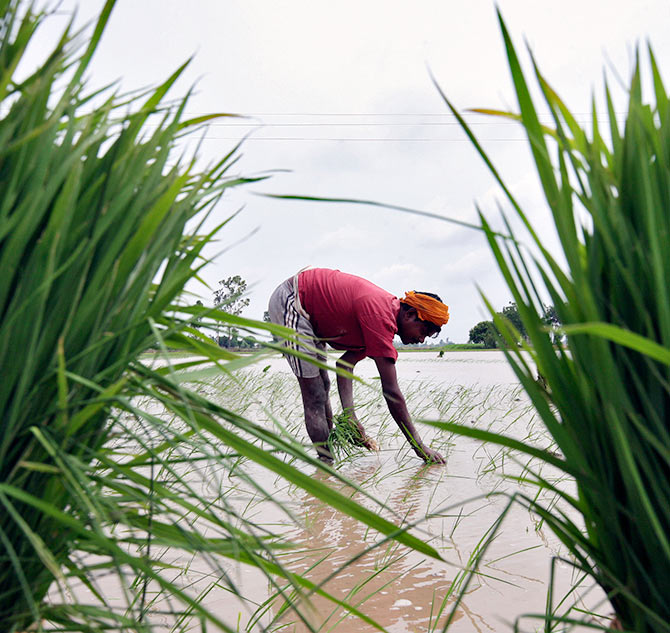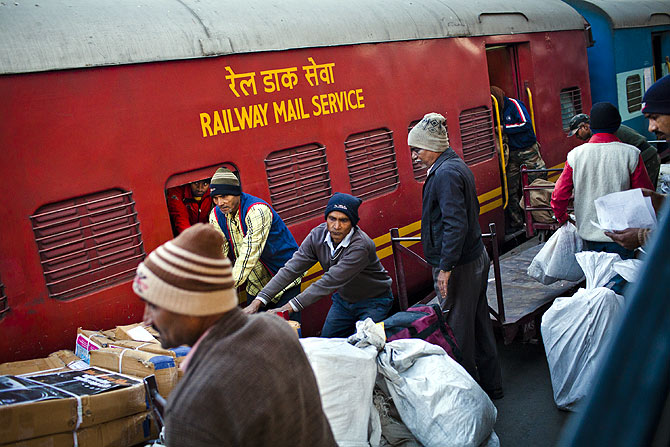 | « Back to article | Print this article |
Budget proposals can tame food inflation; implementation is key
The greatest budgetary importance has been accorded to enhancing credit availability to farmers.
Of all the measures in the final Union Budget and Rail Budget for 2014-15, the micro-interventions that address food inflation by dismantling supply-side barriers are the most important.
They carry added significance in a year when the monsoon has been deficient in a wide swathe of the western and northern parts of the country.
The promise to bring down the hold of wholesale warlords in the Agricultural Produce Marketing Committee (APMC) designated market yards is the most significant.
The central government "will work closely with state governments" to amend their respective APMC Acts, and provide for alternative private market yards.
The new market spaces are expected to be privately funded; but, even so, the state government will have to provide approach roads, and much else besides, extending possibly to developing competing networks of aggregators.
This is largely a political battle, which can only be won by an adroit mix of persuasion and funding for states.
Please click NEXT for more...
Budget proposals can tame food inflation; implementation is key
There is no direct budgetary provision towards this - which is perhaps wise, because that would pose the problem of having to define state shares within it.
The rural last-mile road connectivity scheme (PMGSY) gets nearly Rs 15,000 crore (Rs 150 billion), and goes as a grant to states, but it cannot fund upgradation of access to market centres.
The Rural Infrastructure Development Fund which merely on-lends to state governments commercial bank funding earmarked for the priority sector, is not a concessional scheme.
A new borrowing avenue for states is the resurrected Kisan Vikas Patra (KVP), but what it will do for state finances depends on how it is configured.
This instrument will feed into the National Small Savings Fund (NSSF) in the Public Account, from which states are presently compelled to borrow at least one-half of collections from their respective jurisdictions.
The currently prevailing NSSF lending rate to states is reported in the budget documents at 9.5 per cent, higher than yields on state government securities on financial markets.
Please click NEXT for more...
Budget proposals can tame food inflation; implementation is key
KVP was closed some years ago for enabling laundering of undeclared income - it can be bought with cash, and cumulates until it doubles in value to cash-out at maturity.
If the past is any guide, collections through the KVP should prove quite buoyant.
The overall borrowing of states across all avenues is capped in their Fiscal Responsibility legislation as a percentage of state domestic product.
If KVP accretions to the NSSF are added to what the states must borrow half of - and at 9.5 per cent - it will displace cheaper market borrowing and could actually worsen their fiscal situation.
So presumably, the KVP will be a carve-out, and notified as a back-to-back instrument, passed on to states with the commitment to pay double the face value to the holder at the time of maturity.
Even so, the implicit interest defined by the period over which it doubles has to be lower than the prevailing yield on government securities, for the states to actually get some benefit from displacement of market borrowings by the KVP.
Therefore the maturity period and configuration of the new KVP will have to be carefully weighed.
Please click NEXT for more...
Budget proposals can tame food inflation; implementation is key
Two supporting budgetary provisions are Rs 5,000 crore (Rs 50 billion) towards the Warehouse Infrastructure Fund, and Rs 500 crore (Rs 5 billion) for a Price Stabilisation Fund.
The price stabilisation fund will call for processing capacity for perishables. Perhaps the new agri-tech infrastructure fund (Rs 100 crore or Rs 1 billion) is intended for this.
The expectation seems to be that private entrepreneurs will respond to a small reduction in excise duty on specified food processing and packaging machinery from 10 to six per cent, although the duty drop could have gone all the way to zero with no significant revenue loss.
The Rail Budget also provides for temperature controlled warehousing of fruits and vegetables by the Central Railside Warehousing Corporation, at 10 locations - a small beginning to serve a vast unmet need.
Then there is a set of measures to address physical inputs into agriculture, which can yield productivity returns only in the medium term: a new Sinchai Yojana for irrigation (Rs 1,000 crore), and the promise of a new urea policy, hopefully soon.
The damage done by unbalanced urea application does not have to wait for the diagnostics that will emerge out of soil health assessments.
Please click NEXT for more...
Budget proposals can tame food inflation; implementation is key
The greatest budgetary importance has been accorded to enhancing credit availability to farmers.
There is a massive Rs 50,000-crore (Rs 500 billion) contribution towards refinance for short term co-operative rural credit (STCRC), a fund set up in 2008-09.
Another pre-existing interest subvention scheme for short-term crop loans has been continued. T
here are two new provisions, one for long-term rural credit (Rs 5,000 crore for refinance support through NABARD), and one for building 2,000 producers' organisations across the country over two years (Rs 200 crore or Rs 2 billion).
There is also an unfunded initiative to provide access to credit for 500,000 joint groups of landless farmers through NABARD, which will benefit many landless women farmers.
The Rail Budget draws attention to the problem of empty wagons on the return journey of as many as one-third of freight trains.
Budget proposals can tame food inflation; implementation is key
In effect, this means that for a freight train carrying goods only one way, the freight revenue realisation by the railway is half the freight rate levied.
Trial on a pilot basis of automated freight rate reduction for goods carried on the return journey is proposed.
The huge delay in covering any given distance compared to road transportation is another deterrent to rail haulage.
The practice of loading wagons with multiple destinations on a single train is what causes the delay, as trains are shunted aside for wagons to be detached and re-attached.
A number of solutions are possible - such as, for instance, homogenisation of trains by type of good carried and nodes served on designated days of the week.
Rail transport of goods is more cost-effective than road haulage, but has steadily lost market share for a number of reasons that are amenable to correction.
If all the several budgetary initiatives to bring down food and overall inflation are well implemented, the praja would be happy. The great sage Kautilya would approve.
